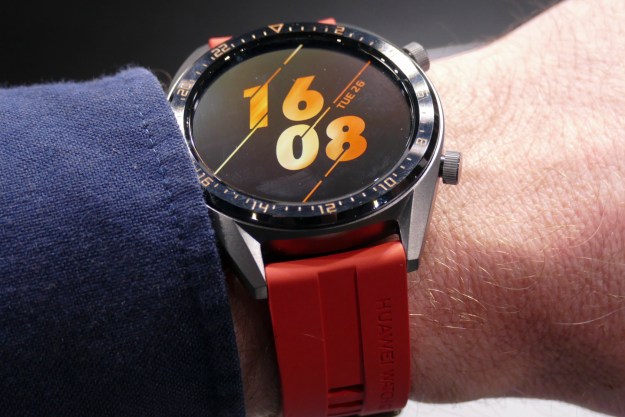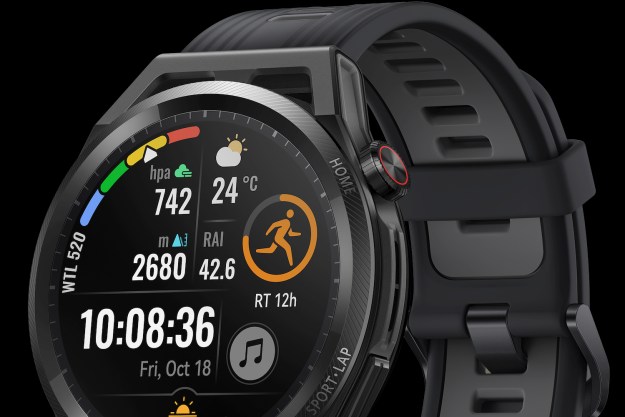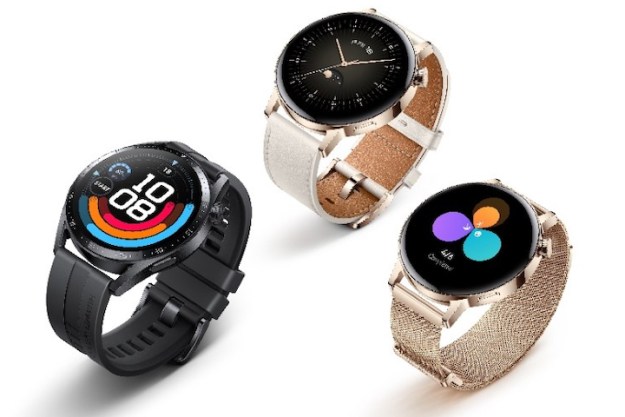
“Improved design and the choice of two sizes makes the Huawei Watch GT 2019 more wearable, but at a higher price and without a feature overhaul.”
- 42mm Watch GT is a good size
- Great design
- Good casual fitness features
- Long battery life on the 46mm model
- Works with iOS and Android
- Higher price
- Shorter battery life on the 42mm model
Huawei’s new Watch GT models are not functionally different from the original it debuted in 2018, but the decision to offer a smaller size may prove to be a good one. The Watch GT now comes in two sizes — a 46mm Active case and a 42mm Elegant case.
The larger of the two looks identical to the original Huawei Watch GT, with two side buttons, a metal and plastic case, grippy side buttons, and a sporty bezel around a 1.4-inch screen. The 42mm model shrinks the screen to 1.2-inches, adds a stylish ceramic bezel, and smooth side buttons.
42mm Watch GT Elegant
Let’s talk about the 42mm Elegant model first, since it offers more differences to what we’ve seen from Huawei so far. The 1.2-inch screen size works really well on smartwatches, as it doesn’t dominate small wrists, or look too small on larger ones. But Huawei is clearly aiming the 42mm Watch GT at women, as the strap fitted to the ones I tried were small, and I only had three or so holes left on the strap when I secured it. The strap isn’t designed to fit larger wrists.
It’s a shame, as the black model is beautiful. It’s hard to see in the pictures, but the ceramic bezel has a deep purple sheen to it that’s visible only in certain light conditions, and I imagine that outside in the sun it’ll look fantastic. There’s no reason this couldn’t be a unisex watch.
The white Watch GT Elegant looks even more feminine, but the combination of the polished stainless steel case and smooth white bezel is too classy to ignore. Even the plastic lower section of the case has been visually improved. Both look excellent.
46mm Watch GT Active
The 46mm Active hasn’t changed much from the original Watch GT, but the side buttons now have a grippy surface, and the body comes in a matte metal, rather than the black or polished versions seen on the first. This makes it more stylish, and less cheap-looking. A black and gold bezel is used on both models, combined with a dark green or orange silicone strap. A wider variety of watch faces are available, and they’re much improved over the basic selection previously available. The new Watch GT has become a watch I’d want to wear more often.
Aside from the new size, slight design changes, and the more robust watch faces, the Watch GT has only one major new feature — a triathlon tracking mode. The Watch GT syncs with the Huawei Health app on your phone — it’s available for Android and iOS, not just Huawei phones — and it’s surprisingly capable. But the seriously sporty (such as those attempting a triathlon) may want to select a more hardcore fitness watch than the GT.
The other technical alteration is the battery. Huawei hasn’t stated capacity, but the 42mm Watch GT will only return a week of use before needing to be recharged, compared to the two weeks for the 46mm model. Use the heart rate sensor and the GPS regularly, and that time will fall again. The long battery life was a big selling point of the original Watch GT, and the 42mm sacrifices this in the name of style.
Software and features
Huawei uses its own Lite OS for the Watch GT, instead of Google’s Wear OS, and it does so to help extend the battery life. The interface is similar to Wear OS, in that you swipe the screen in various directions, and tap to select your menu choice. Lite OS was one of the disappointments on the original Watch GT, and Huawei has not mentioned specific improvements here. It did respond quickly and scroll smoothly when I tested the new models, but it’s worth remembering they were not connected to a phone at the time. I’ll be able to judge performance better in a longer review.

Sharper looks and more design variety is very important for wearables, and Huawei has expertly accomplished both with the new Watch GTs. Our concerns continue to be the feature set — no streaming music support on the original, for example — and the speed of the operating system. The price has crept up too, making it contend with stronger competition.
Price and conclusion
The Huawei Watch GT Active (46mm) costs 250 euros, or around $280, and the Elegant (42mm) is 230 euros, or approximately $260. This is considerably more than the basic 180 euro Watch GT, but equal to the more stylish Watch GT Classic. This puts it in competition with the Fossil Sport watch, which can’t match the battery life but has many more features including the ability to stream music, and the Samsung Galaxy Watch Active. Spend a little more and even an Apple Watch Series 3 comes into view if you find the right deal.
The Watch GT Active and Elegant are available to order now from Huawei, but no U.S. launch has been announced. This may change in the future. I like the Watch GT, but prefer it at the low 180 euro price, when the competition isn’t as strong and feature omissions can be forgiven. The look may be right for the new models, but we’ll have to test it out for longer to discover if the rest justifies spending more to get it.
Editors' Recommendations
- Garmin’s newest running watch is cheaper than you’d expect
- The Huawei Watch Ultimate looks like the perfect Apple Watch Ultra rival
- Does the Google Pixel Watch have fall detection? Not yet, but it’s coming soon
- Oppo’s latest Apple Watch clone has an important spec under the hood
- TicWatch Pro 3 Ultra hands-on review: Amazing battery life








